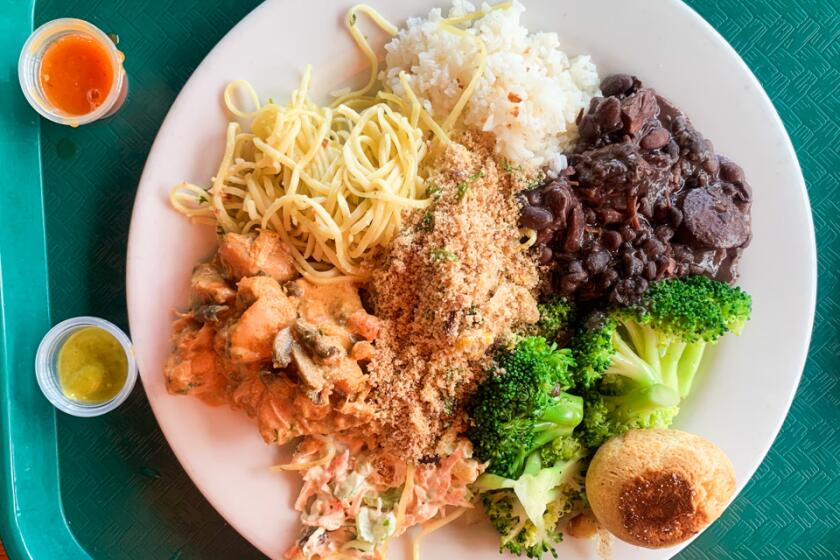Brew Is True in Munich
Bavaria’s capital city is indeed the beer capital of West Germany, but many people think the truest experience of quaffing the local brew means crowded, oompah-loud surroundings.
In Munich that would best describe the famous Hofbrauhaus beer hall and the annual Oktoberfest, an epic bash in which the equivalent of 5.5 million quarts are consumed by 7 million revelers in 16 days.
In mild seasons you’ll find a much more peaceful alternative, treating yourself to the casual atmosphere of a beer garden. This is Bavarian gemutlichkeit at its very best, because the emphasis is on congeniality rather than hell-raising. No one exhorts you to chug-a-lug yourself into a state of collapse. The idea is, simply, to sit, sip and socialize in a leisurely outdoor gathering place.
About 50 such places are scattered throughout Munich. Some are big and cosmopolitan, like the Aumeister, one of four beer gardens in the sprawling Englischer Garten. The Chinesischer Turm, also in this park, is the largest beer garden of all, with places for 6,000 people.
Another is the Hirschgarten near Schloss Nymphenburg, northwest of the city center. Others are more neighborly and smaller, the kind you have to seek out for the reward of mixing in with residents.
I’ve found a favorite at the Max Emanuel Brauerei on Adalbert Strasse. It’s in the lively Schwabing district, close to the university and the Academy of Fine Arts.
The same kind of low-key atmosphere prevails at the Hofbraukeller on the Wiener Platz, close to the Bavarian Parliament building. This beer garden is across the Isar River from the city center in Munich’s Haidhausen district, fast becoming an artists’ quarter.
Three beer gardens in particular are within walking distance of the Marienplatz in the heart of Munich. One is in the middle of the Viktualienmarkt, the city’s outdoor food market. Another is in the lovely setting of the Alte Botanischer Garten and the third, the old Augustinerkeller on Arnulfstrasse, is just beyond the main railroad terminal (Hauptbahnhof) and is frequented by the trendier socialites of Munich, partly because it is near the Bavarian state radio station.
Six-Month Process
The social heritage of beer gardens in the south of Germany is as strong as the pub tradition in England. Beer cellars were usually close to Bavaria’s cold-flowing rivers, with the shade of chestnut trees performing an added cooling function during the six-month aging process of the beer. Just the setting for a beer garden.
Some brewery proprietor came to that inevitable realization, foreseeing the pleasures of family gatherings outdoors, thus a ready-made clientele for the season’s freshest brew.
There’s no way to count all the beer gardens in Bavaria and beyond, but the number of breweries is known. The West German total is 1,250, of which 935 are in Bavaria, where the hops-growing regions in the northern part of this federal republic state are the world’s largest.
Beer gardens have distinct characteristics that differentiate them from the beer halls of Munich. You can, if you wish, have a meal served to you in a beer hall. Music is a featured part of the atmosphere, most of it coming at you in those great oompah blasts.
Beer gardens, by contrast, don’t have such amenities. There are no table servings and you won’t ordinarily hear music. You get your own beer “at the bar” and you’ll usually find snack food at booths, though many people take their own bread, sausage, cheese or whatever else they feel like eating with their suds.
One popular habit is to accompany the beer with a thirst-inducing salted white radish (Radi) . Tablecloths and waitresses are frills that most beer gardens do without. The beer is poured only into the huge, classic one-liter glass stein that Germans call a Mass .
You’ll also get a Mass of brew in the Hofbrauhaus, but all other establishments serve beer by the half-liter (just over a pint). Also available for those preferring less alcohol: Radler , a blend of lemon soda and beer.
The absence of big servings of food harkens back to a royal edict of 1846. By proclamation of Bavaria’s King Ludwig I, citizens were allowed to take their own food to public beer gardens, and table service was simultaneously declared verboten . Thus the same Wittelsbach monarch who made Munich a major artistic and cultural center of Europe also made beer gardens an affordable, democratic family attraction.
At present-day prices, a Mass or approximate quart of beer will ordinarily cost you 5 marks (about $2), and you can nurse it as long as you please in the easygoing atmosphere.
The city’s larger urban beer gardens stay open until midnight, while those in residential areas close at 10 p.m. During the evenings, strings of lights add a twinkle to the convivial scene.
German beer is brewed without chemical additives, in accordance with a 1516 purity law that is the world’s oldest and strictest. All other beers in all other countries have some degree of chemical content.
Beer exported from Germany is by necessity mixed with preservatives for shipment, which is why Germans correctly claim that even the finest brands don’t travel well.
Most German beers that have become American favorites are brewed under license in the United States. So to enjoy the zestiest best of the local beer, you have to come to Germany to drink it.
Now there are rumblings of purist disapproval, caused by Common Market compromises that enable some chemical-additive brews to be imported from other European countries into the Federal Republic.
The golden, sudsy stuff has been the high-caloric “liquid bread” of German farm folk for hundreds of years. Munich has six major breweries. If you come to Bavaria when the beer gardens aren’t in season, remember that each of the city’s breweries has a beer hall.
The normal alcoholic content of German beer is 3 1/2%. The first two weeks of Lent, though, is the traditional strong-beer season, when the figure goes up to 5 1/2%-6%. Bock beer also has a higher alcoholic content, and it’s a Maytime specialty.
Beer From Wheat
I’ve learned to favor Weissbier, a specialty of southern Germany made from wheat rather than barley, with a mild, yeasty taste and the bubbly effect of champagne. According to the custom in this land of beer perfectionists, Weissbier must be served in its own special kind of tall, slender glass, often with a slice of lemon.
There’s something well-nigh perfect about the combination of German beer and German food, and you need not be a confirmed beer drinker to make the discovery. That happened to me one Saturday afternoon in Munich when I sipped sparkling Weissbier and ate Weisswurst, tender-white, steaming-hot sausages smeared with their own sweet mustard (Senf) . Unforgettable.
Beer is taken seriously in Munich. One can, after all, study for a brewmaster’s doctorate at the prestigious Technical Institute. When fire broke out in the National Theater in 1830, beer was used to douse the flames. And when the weather is as hospitable as the city, the amiable beer garden is travel at its best.
For more information contact the German National Tourist Office, 444 S. Flower St., Suite 174, Los Angeles 90017, phone (213) 688-7332. In Munich a city tourism office is central in the Neues Rathaus (New City Hall) on the Marienplatz.
More to Read
Eat your way across L.A.
Get our weekly Tasting Notes newsletter for reviews, news and more.
You may occasionally receive promotional content from the Los Angeles Times.






